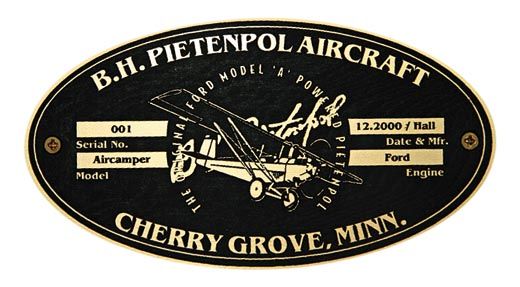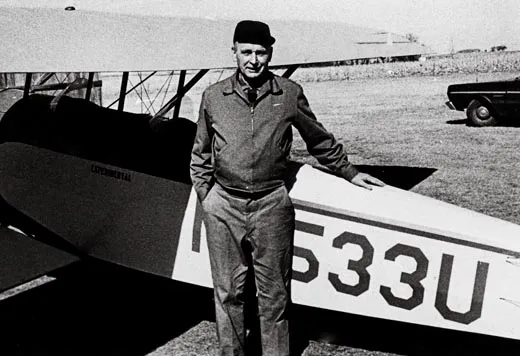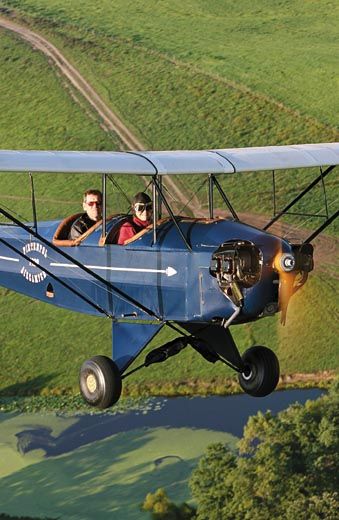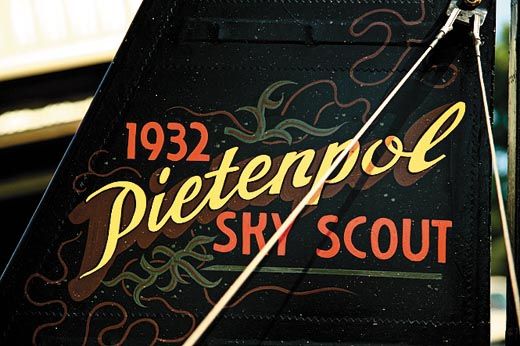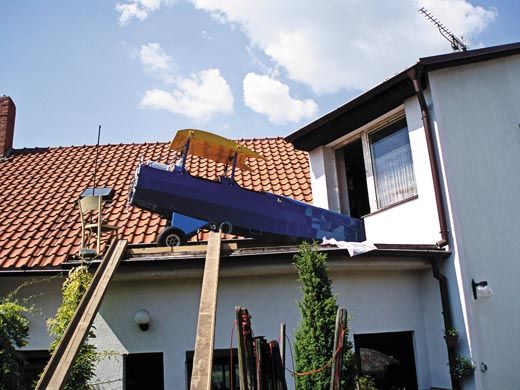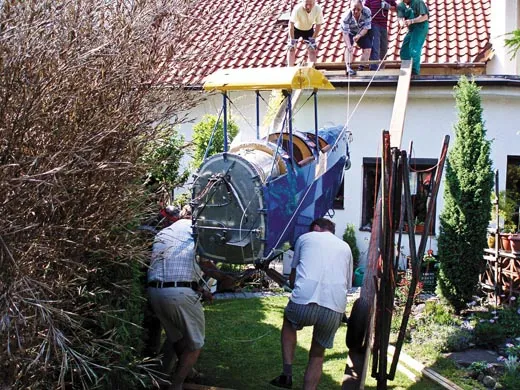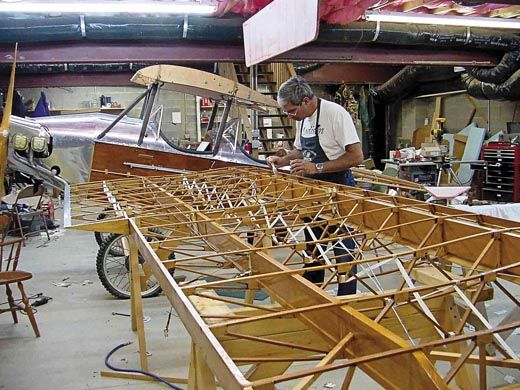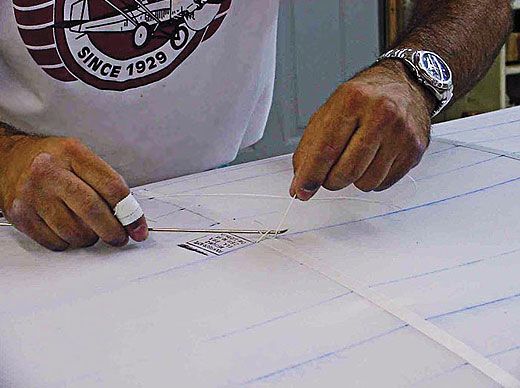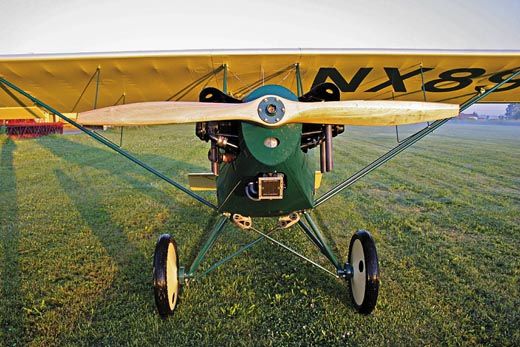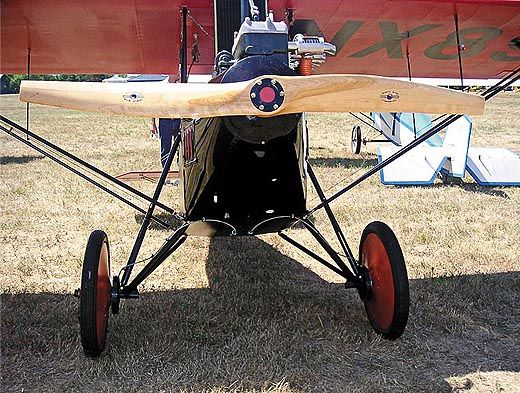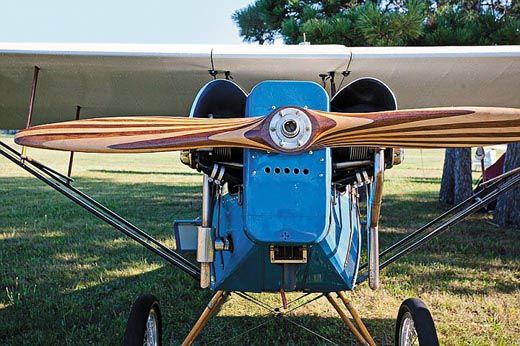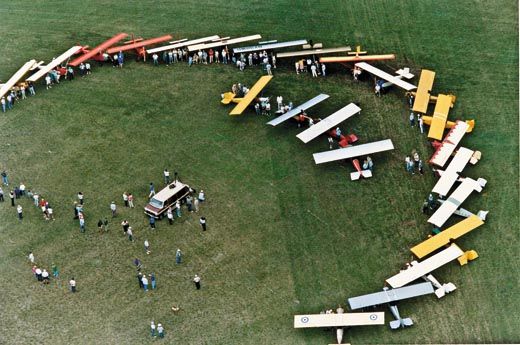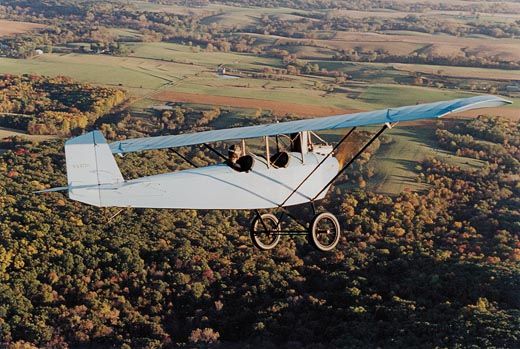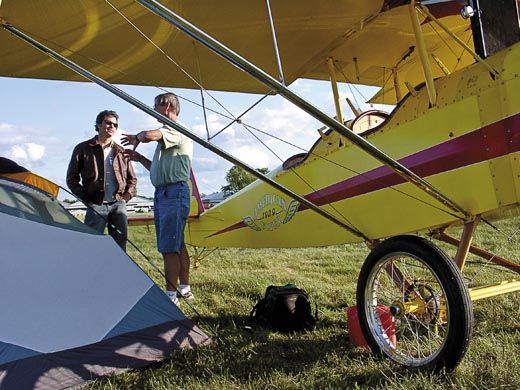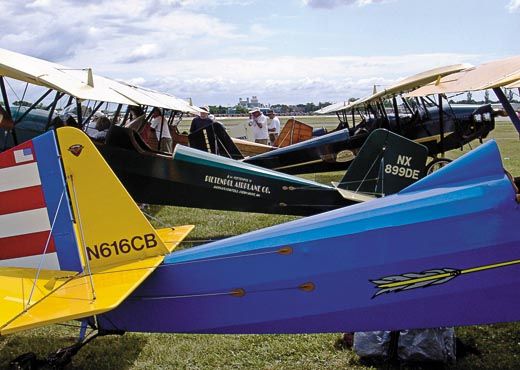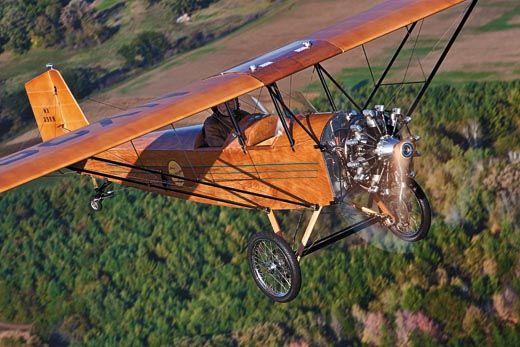The Pride of Cherry Grove
With little more than Bernard Pietenpol’s plans, anybody could build an airplane.
/https://tf-cmsv2-smithsonianmag-media.s3.amazonaws.com/filer/The%20Pride%20of%20Cherry%20Grove%20%20FL.jpg)
Once upon a time in rural Michigan, where I grew up, people used to stop what they were doing when an airplane flew over and watch it until it was almost out of sight. Many of the flights we saw were made by Sherman Edgar, a farmer who lived in an adjacent township.
Edgar had taught himself to fly by building a tail assembly and a wing, then attaching them to a truss-shaped fuselage to make a glider. One day in the early 1930s, my dad took me to watch Edgar’s friend tow him furiously across a field with a Model A Ford. After all the fuss, Edgar gained enough altitude for only a few moments of flight.
Before long, though, the glider morphed into a wood-and-fabric high-wing monoplane constructed from a set of mail-order plans and powered by a Model A Ford engine. Throughout the 1930s, on quiet summer evenings after the chores were done, we became accustomed to the sight and sound of Sherm puttering overhead. As I stood watching Edgar sail past one night in 1938, our last year on the farm, I couldn’t have imagined that four years hence I would be wearing a U.S. Army Air Forces flightsuit while training to fly some of the nation’s newest fighters.
Several years ago, in a hangar discussion with other pilots, I was reminded of the story of Sherman Edgar’s marvelous homebuilt aircraft. “Oh yeah,” somebody said, “that was a Pete ’n’ Paul.” Of course, he meant “Pietenpol,” as in Bernard H. Pietenpol, who in 1929 designed and built the first of this type. Furthermore, I soon found out that an airplane I had thought was ancient history still existed and even thrived, like a population of rare birds nesting next to dirt and grass strips and the runways of small-town airports.
To many of the people who build and fly them, the Piet, as it is affectionately known, is an almost mystical symbol of two intrinsically American values—self-reliance and freedom—and a time machine back to the early days of aviation.
The Piet’s story began in the hamlet of Cherry Grove, in southeast Minnesota, near Iowa. In 1919, with little more than an eighth grade education and an innate talent for mechanics, Pietenpol opened an auto repair shop in his father’s barn. He soon developed a reputation for being able to fix anything, from farm equipment to motorcycles.
Along the way, he discovered airplanes. He experimented with constructing a series of biplanes by working with materials purchased from lumberyards and hardware stores, including unbleached muslin, which he used to cover the fuselage and control surfaces. Since he couldn’t afford to buy an aircraft engine for his first biplane—a shaky, hardly airworthy contraption—he decided to power the aircraft with an engine from a Model T Ford automobile.
Pietenpol took a few flying lessons in a Curtiss JN-4D, the World War I-era biplane, and even bought one when they were sold off as military surplus. But he never liked it, and soon got rid of it.
The fourth aircraft that Pietenpol built was a single-place, high-wing monoplane. Chet Peek, an engineer, pilot, restorer of antique airplanes, and aviation historian, whose book The Pietenpol Story is the definitive history of Pietenpol’s career, surmises that Pietenpol’s design was inspired by the Heath Parasol, a small kitplane that was popular at the time.
By May 1929, Pietenpol had completed a second version of his high-wing monoplane, adding another cockpit. This time he had the power he wanted: In late 1927, the Model A Ford, with its 40-horsepower engine, had arrived. Pietenpol replaced the engine’s heavy battery, distributor, and generator with a magneto, and the exhaust manifold with short, straight stacks. He mounted the engine backward, attaching the prop to the forward-facing flywheel, and the radiator aft, where it stuck up prominently just ahead of the front cockpit.
When the aviation editor of Modern Mechanics and Inventions wrote in 1929 that it was not likely that an automobile engine could be adapted for flight, Pietenpol and a friend, Don Finke, flew two of the new “two-place” machines up to Minneapolis on April 14, 1930, to prove him wrong. The editor, Westy Farmer, was won over, and the magazine printed drawings and photographs that publicized the new airplane.
The magazine dubbed the aircraft the “Air Camper,” and the name stuck. A few years later, Pietenpol introduced the single-place Sky Scout, but the Air Camper has remained the overwhelming favorite of builders. Modern Mechanics published a set of Air Camper plans in 1932 in its annual Flying and Glider Manual.
Back in Cherry Grove, an 18-year-old friend of Pietenpol’s, Orrin Hoopman, drafted a second set of plans for the Air Camper in 1934. Pietenpol began selling them—along with instructions on how to convert the Model A engine—for $7.50 a set. Today, builders can order the very same plans for $100 from Pietenpol’s son Don, who says there continues to be a slow but steady demand. Additionally, the store in the Experimental Aircraft Association’s museum at Oshkosh, Wisconsin, sells a reprint of the 1932 Flying and Glider Manual for $6.95.
Bernard Pietenpol spent the rest of his life in Cherry Grove. With the onset of World War II, the demand for Pietenpol kits and plans plummeted. Says Don: “After the war, we ran the shop for a couple of years and almost starved.” His father gave up trying to make money on his aircraft designs and opened a television and radio repair shop. He continued building his own airplanes until 1970, and flew until he was 80. Pietenpol builders continued to make pilgrimages to Cherry Grove to seek his counsel.
Pietenpol died in 1984, at the age of 83. Today, his garage workshop is listed in the National Register of Historic Places. The hangar he built in Cherry Grove has been dismantled and reconstructed next to the EAA’s museum, which has two of his Air Campers in its collection.
Pietenpol’s legacy is an elegant little aircraft that anyone with diligence and modest skills can build with ordinary tools and readily available materials. In fact, that’s the only way you can get one, unless you buy one from someone who has already done the work. For more than 80 years, people have been constructing Piets in barns, hangars, garages, basements, workshops, and living rooms—anywhere they could find space to lay out a jig for the fuselage framework and hang a one-piece wing. (Pietenpol built his first airplanes in an abandoned Lutheran church.)
More than 300 Pietenpols are registered with the Federal Aviation Administration. Perhaps dozens more Pietenpols are under construction. They have been built in Canada, the United Kingdom, Spain, and Brazil, and small but enthusiastic groups can be found in Australia and New Zealand. Recently a Piet was spotted in Russia.
There’s no mistaking a Pietenpol Air Camper: the high parasol wing, boxy fuselage, and angular tail structures. Yet of the hundreds in existence, no two are exactly alike. Pietenpol kept making changes to the Air Camper, and he openly encouraged others to do the same. Says Don: “My dad used to say that he built the best airplane he could, and if somebody can build a better one, go ahead and do it.” (Pietenpol liked improvements, but he wasn’t much for frills. Somebody once said that if the Shakers had built airplanes, they would have looked like Pietenpols.)
The original plans, whether deliberately or not, seem to demand experimenting. “There are a number of places where the plans do not have certain dimensions, and there are other places where the dimensions are actually wrong,” says Doc Mosher, a retired corporate pilot and editor of a newsletter about the Pietenpol. “And we all find this out after a while, and then we all laugh and have a beer and say, ‘Well, that’s why it’s called experimental.’ ”
Some changes, however, have gone too far, fueling the argument over what is and what isn’t a true Pietenpol. “If it wasn’t built from the original plans, it’s not a Pietenpol,” says Don.
Not considered real Air Campers: at least one biplane model, an ultralight, and a low-wing version. One major modification occurred in the late 1950s, when Ohioan John Grega decided to modernize the design by incorporating parts from the Piper J-3 Cub, including the landing gear and tail wheel. Grega powered his tweaked airplane with a Continental A65 engine. Called the GN-1 Air Camper, it has been much copied over the years (with further modifications), although some are still reluctant to welcome it into the Pietenpol flock. Don Pietenpol is adamant when he says that Grega’s design “is in no way” a Pietenpol. Nevertheless, some pilots say it flies like one, and to the unschooled eye, it looks like one.
“It’s fun building Pietenpols,” says Ed Sampson, a retired hardware dealer in Belview, Minnesota. “It isn’t hard.” He should know: He’s built eight Air Campers, one of which he still owns, although his health now prevents him from flying it. “Bernard told me once he’d like to build one more airplane, and all it would have in it was basic controls and an on/off switch,” says Sampson. “He told me if you don’t put it on there, it doesn’t give you trouble. That was his philosophy.”
To keep weight at a desirable 600 to 800 pounds, many builders today still forgo items such as self starters (with their heavy batteries), radios, and wheel brakes. Those who couldn’t resist adding weight had to look for an engine with more power than the Ford Model A. As a result, the Air Camper has been flown with more kinds of engines—at least 30, and maybe as many as 60—than probably any other airframe in history.
Michael Cuy, an engineering technician at NASA’s Glenn Research Center in Cleveland, Ohio, had just bought a half-interest in an Aeronca Champ when a friend gave him a ride in a Pietenpol. “I had never heard of a Piet before,” he says. “It took me by surprise. I realized how much fun and how economical it was. We didn’t have a starter, generator, electric—nothing. Just an engine and a sectional chart. I thought, Wow, I can fly wherever and whenever I want at a real reasonable price.”
Cuy and his fellow owner sold their Aeronca, and he ordered plans from Don Pietenpol. He chose a Continental A65 engine over the Model A because the extra power would enable him to carry passengers. “I never totaled up my bills, but I’m guessing it cost about $13,000,” he says. “But if you’re a good scrounger and you get some used parts, I think you can do it for seven thousand.”
If there is such a thing as a deluxe Air Camper, Dick Navratil from Arden Hills, Minnesota, has one. He first saw a Pietenpol in the 1970s at Oshkosh. Says Navratil: “It was the most beautiful airplane I had ever seen, and I decided then and there that someday I was going to have one.” When he finally got around to building one, it took him four years and three months. Like others, he looked for a way to save money, and one was to use house paint to cover the Piet. “The Sherwin-Williams paint has UV protection in it, and the latex is flexible so it doesn’t crack,” he says. He also added brakes, a tail wheel, and a 12-volt battery, bringing the craft’s weight to nearly 700 pounds. But he began to think of ways he could build a better one.
Then he saw a Rotec radial engine. Manufactured in Australia, the model he wanted generated 110 horsepower—and a nice throaty sound. “I wanted something that nobody else has,” he says. At 810 pounds empty, Navratil’s second Piet is a heavy one, but “the power response is incredible,” says Navratil. “On both my Piets, the controls are extremely responsive, but I think the additional weight of the new one gives it more stability. I think Bernard Pietenpol would be doing this himself if he were still around.”
Despite being widely scattered and working almost entirely in isolation, Piet builders and fliers are closely bound. Matt Dralle maintains an online forum for Pietenpol builders to post problems and get solutions. The quarterly Brodhead Pietenpol Association Newsletter shares news, photographs, building tips, and advice from experts and advertises parts and fully or partially completed Piets for sale. Says editor Doc Mosher: “You can’t buy a kit, so you have to go to the lumberyard and buy the lumber, saw it up, plane it and glue it, and make your airplane. And every one is different.”
What you have after all those hours of lonely shop work is a little wood airplane that cannot be said, in the words of poet John Gillespie Magee Jr., to “have slipped the surly bonds of earth” and go “where never lark, or even eagle, flew.” The Pietenpol motto is “Low and Slow Since 1929.” Flying in Piets is a noisy experience, and the snug cockpits, with their hard wood seats, leave occupants exposed to the weather. Cruise speeds are somewhere between 70 and 80 mph, and the airplanes with the smaller engines are laborious climbers. So why build one?
“It’s just really a lot of fun,” says Navratil. “When I was flying my company’s Piper Seneca for business, I’d flip on the autopilot and take it up to 15,000 feet and never touch the controls. I’d do whatever the controller tells me to do. In the Piet, I’m most commonly hardly more than 500 feet: Down there you can smell the farms and you can putter around and wave at people on the ground.”
The place to get together with other Piet builders and owners is the airport at Brodhead, Wisconsin, in the rolling green landscape of the south-central part of the state. Every summer since 1975, the airport has been hosting an annual fly-in. It seems an appropriate meeting place for an aero club in love with a 1929 homebuilt. Its two broad turf runways are bordered by a two-lane road and fields of tall corn, with a fringe of trees on one side.
Most of the aircraft at the fly-ins are from Wisconsin and neighboring states in the Midwest. In 2007, when I was there, 21 Piets were visiting, more than average. Among them was an Air Camper from Quebec; the French-Canadian pilot had never seen another Piet until he landed at Brodhead.
The Pietenpol, with its short range and slow speed, is not a comfortable airplane for long-distance flights. In 1993, though, M.T. “Sparky” Sparks and his stepson Scott Liefeld stuffed their gear into the front cockpits of two Air Campers and took off from Gillespie Field in San Diego, California, for Brodhead. It was a 15-day journey, during which they stopped for fuel 46 times.
More people drive to Brodhead than fly. The land around the airfield is open to campers, and the scene has the feel of a country fair. There is Doc Mosher and wife Dee at the table, ready to sign you in and give you a handout outlining the day’s forums, which are hosted by Pietenpol experts. Mosher and his wife also remind you to get tickets for Saturday night’s traditional grilled pork chop dinner. Soft drinks from the cooler are 75 cents, paid for on the honor system. People mill around the parked airplanes, talk to the owners, and admire the exquisite handiwork that can go into a Pietenpol.
Hang around the airplanes long enough and somebody will offer to take you for a ride. Pete Smith, from Lake City, Michigan, asked me if I wanted to go, and I accepted immediately. Getting into the front cockpit isn’t easy: You have to squirm between the struts and wires without whacking your head. It takes precise instructions from the pilot every step of the way.
After a quick liftoff and gentle climbout, we level off at 500 to 600 feet and cruise above farmland at a leisurely 75 mph. The Piet feels stable and predictable. The visibility is spectacular, especially since you can look over the side of the fuselage almost straight down. I observe things that I never seem to notice while flying in other airplanes: birds, people and cars on the ground, and swirling patterns made by breeze-swept corn tassels.
When I was a kid, I sometimes got invited to go for a ride in a Ford roadster with the top down. My flight in the Piet reminds me of those rides—that feeling of gleeful release.
Reminders of Pietenpol History are plentiful. You can still find people who knew and worked with Bernard Pietenpol, and some of the airplanes he built still exist. His earliest surviving Air Camper, N12937, first flew on April 20, 1933. It survived five owners, two serious crashes, several restorations, and several thousand flying hours. Today it is displayed at the EAA museum.
Don Pietenpol lived the history. As far as he can remember, airplanes were always around. When he was three, he took his first ride in an Air Camper, which had no seatbelts. “My dad took the belt off his pants and strapped me in the front cockpit,” he recalls. Bernard taught him to fly when he was nine, and he got his pilot’s license at 16. Don was a U.S. Air Force pilot before working as an engineer at IBM in nearby Rochester, Minnesota, where he still lives.
Bill Knight, who lives in Brodhead, owns the last Air Camper Pietenpol ever built. It was finished in 1969. Still flyable, it is powered by a Chevy Corvair engine. When Pietenpol’s grandson put it up for sale, Knight bought it because, he says, he didn’t want it to go to a museum. “I thought it should be available where people could see how Bernie himself built an airplane,” says Knight, who frequently shows off his Air Camper at vintage-airplane fly-ins around the country.
Modern Piet builders are acutely aware of the cherished tradition begun in a far corner of Minnesota 81 years ago. Oscar Zuniga, an engineer and Pietenpol owner in San Antonio, Texas, says: “If you’re looking for a ‘Insert Tab A into Slot B’ type of manual, you won’t find it. That’s the beauty of it. It’s like sitting down at your dining room table and emptying out all the pieces of a big, beautiful jigsaw puzzle of Cherry Grove, Minnesota, and then just sorting it out bit by bit. I work on a new and interesting part every day until I just can’t seem to make any progress there, then I work on another area for a while.
“Building a Piet is the same way,” he says. “And with this jigsaw puzzle, you’ll find a little bit of Mr. Pietenpol’s airplane and barn in every piece.”
Marshall Lumsden is a former World War II fighter pilot.
